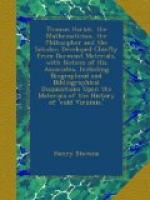Raleigh was now thirty-three, a man of position, of large heart and large income, a popular courtier high in royal favor, a man of foreign travel, great experience and extensive acquirements. He had served under Coligni with his protestant friends in France; subsequently served under William of Orange in Flanders; had served his Queen in Ireland; under Gilbert’s patent, contemplated a voyage to Newfoundland in 1578; and in 1583 was ready to embark himself again, but by some happy accident did not go, though he fitted out and sent a large ship at his own cost bearing his own name, which ship however put back on account of the outbreak of some contagion. Fully alive to the wants, plans, and desires of the Huguenots, he had not only informed himself of their Florida schemes, but had promoted the publication of their history, and secured the interest and active co-operation of the most important survivor of them all, Jaques LeMoyne, the painter, who having escaped landed destitute in Wales, and subsequently entered the service of Raleigh who had him safely lodged in the Blackfriars. He had also, how or when precisely is not known, secured the active aid and facile pen of the geographical Richard Hakluyt, who wrote for him, as no man else could write, in 1584, a treatise on Western Planting, a work intended probably to prime the ministry and the Parliament, to enable Raleigh first to secure the confirmation of his patent, and afterwards the co-operation and active interest of the nobility and gentry in his enterprise. This important hitherto unpublished volume of sixty-three large folio pages in the hand writing of Hakluyt, after having probably served its purpose and lain dormant for nearly three centuries, was bought at Earl Mountnorris’s sale at Arley Castle in December 1852, by Mr Henry Stevens of Vermont, who, as he himself informs us, after partly copying it, and endeavouring in vain to place it in some public or private library in England or the United States, threw it into auction, where it was sold by Messrs Puttick and Simpson in May 1854, for £44, as lot 474, Sir Thomas Phillipps being the purchaser. The manuscript still adorns the Phillipps library at Cheltenham. In 1868 a copy of this most suggestive volume was obtained by the late Dr Leonard Woods for the Maine Historical Society, and has since been edited with valuable notes by Mr Charles Deane of Cambridge and with an Introduction by Dr Woods. It appeared in 1877 as the second volume of the second series of the Society’s Collections.
This Treatise of Hakluyt under Raleigh’s inspiration may be regarded as the harbinger of Virginia history. Though intended for a special purpose, it is of the highest importance in developing the history of English maritime policy at that time, and defining the growth of the English arguments, advantages and reasons for western planting. The book is full of personal hints, and is immensely suggestive, showing us more than anything else the master hand of Master Hakluyt




